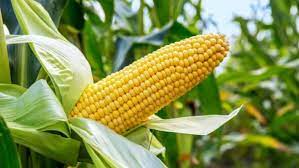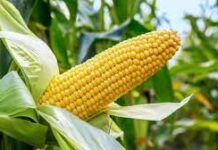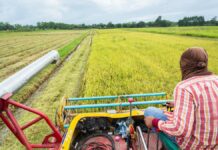Rainfall deficit or prolong dry-spell in South West and some part of the South East, flooding in some parts of the North East and North West as well as inadequate fertilizer application on maize farms are said to be the factors responsible for the current shortfall in the maize production.
The national president of the Maize Association of Nigeria (MAAN), Alhaji Abubakar Bello Funtua, said that despite the increase in land area of cultivation, maize output declined from “12.6 million tons in 2019 to 12.4 million in 2020, representing a 1.55 per cent reduction.
Maize supply is apparently the country’s major problem. This is because its value chain activities are massive, such that any shortfall can trigger major industry disaster. Most of the grains produced locally are consumed in various commercial sectors.
Maize farmers said that in 2020, about 6.04 million hectares were cultivated, as against the 6.03 hectares cultivated in 2019.
Currently, the national average yield of maize has declined from 2.09 tons per hectare in 2019 to 2.05 tons per hectare in 2020, while the domestic demands continue to rise above 15million metric tons.
READ ALSO: US-based Fulani Group Provers Solution to Herders/Farmers’ Crisis in Nigeria
This declining yield is also attributed to low level of adoption of improved seeds and drought tolerant maize varieties by millions of farmers as noted by the wet season Agricultural Performance Survey (APS) national report, 2020.
A former Minister of Agriculture and Rural Development, Alhaji Sabo Nanono, suggested that the country must create a ‘safety net’ for maize to achieve self-sufficiency in them.
Alhaji Sabo said maize and rice had become what he called ‘political crops,’ adding that Nigerians were very sensitive to their prices, which attracted huge national reactions that were sometimes political.
It should be noted that since 2019, farmers have been wailing over a sudden rise in the cost of inputs, which constitute about 70 per cent of feed components. This forced a bag of feed to rise from N2,700 to N5,600 within 12 months, and has remained so in the last 36 months.
In addition to the cost of maize, which swelled from N140,000 to N223,000 per metric tonne, the inability of the farmers to access vaccines for their birds against avian influenza (bird flu), has further worsened their situation. A poultry farmer, Mr. Idowu Asenuga, calls it a major disaster for the poultry sector.
The recent shortfall in maize production in Nigeria has pushed policymakers to search for viable alternatives, with some, like poultry farmers, calling for importation until the demand gap is closed. This call, however, did not go down well with maize farmers, who see it as “unpatriotic.”
The president of the MAAN, Funtua, admitted that the country had a shortfall in maize supply, but attributed it to a number of factors.
He stated in a conference on maize organised by Bayer that “About 50 per cent of the maize produced is used as animal feed, with the poultry industry claiming the bulk of the country’s total feed production. Nevertheless, to head-off food crisis as a result of the coronavirus pandemic, the Central Bank of Nigeria (CBN) granted import waivers to four agro-processing companies to import 262,000 tons of maize to bridge the shortfall in production and augment local production,”
He, however, warned that even the 262,000 tons of maize imported would not cut down the price of maize produced locally, as local supply gaps are expected to persist. The current price of maize forced many poultry farmers to shut down operations, leading to the loss of jobs and investments, which brought many farmers to their knees.
It is also worthy of note that in spite of the federal government’s approval to release 30,000 tons of maize from the National Strategic Grain Reserve to support the Poultry Association of Nigeria (PAN) at a subsidized rate, the weak reserve system could not sustain the needs of the farmers. Experts like Professor Victor Okoruwa, an Agric-economist, warned this might happen because of weak food reserve system.
The general constraints of maize productivity, even before the COVID-19, has continued to persist, with the invasion of fall army worm, just as flooding and draught/prolonged dry spells destroyed thousands of hectares of maize and sorghum fields across the country.
Incidents of pests and diseases on crops were reported in more than 30 states. Cereals and legumes were generally infested with army worm, stem borers, pod borers and birds. Fall army worm was reported in all the states, with an average yield loss of 45 per cent.
Agricultural development projects are mostly strangled, highly under-staffed and underfunded by most state governors, which left farmers without quality information for agricultural decisions. Inaccessibility and affordability of hybrid seeds have continued to push the country’s maize yield (2.9 tons) to far below global average of 10.5 tons per hectare
According to experts. Africa is known as a drought-prone continent because it has recorded three out of the four global drought events in the last two decades, occasioned by climate change.
A seed breeder and the Chief Executive Officer of the Institute of Agricultural Research, Zaria, Professor Mohammed Fagie Ishyiaku, said the recent outbreak of the invasive fall army worm was a big threat to maize production in Africa, with an estimated annual yield loss worth USD 2.48 – 6.19billion in 12 countries, including Nigeria.
“The fall army worm poses a significant risk to 12.5million maize farmers in Nigeria. An estimation of N268billion is spent annually in the purchase of insecticides used to spray maize in Nigeria.
“The efforts we are making to improve maize production in Nigeria is aimed at not only closing the around 5 million metric tons of national demand deficit for maize grains, but also to boost production to allow for export.
“The cost benefit of our farmers is N58bn annually if 1.2 million hectares of maize farm out of the 12.5million hectares are planted with TELA maize as a result of the yield advantage alone.
“Also, farmers will save the cost of chemical insecticides worth over N26bn annually. Other intangible benefits include healthier farmers and environment as a result of none use of harmful insecticides,” he said.
It was also established that Nigeria’s seed system needs to be properly developed like their counterparts in South Africa, Kenya and Zambia. Because most of the local varieties used by farmers lag far behind the rest of the world in terms of yield.
Dr. Abubakar said, “Harvests per hectare for major crops like maize can be as much as 80 per cent below their potential. More importantly, this yield gap is a major reason why farmers in Africa are not producing enough food to sustain the continent’s rapid growing population.
According to Abubakar, the desire to give African farmers a wider range of seed choices, including access to seed of highly productive crop varieties, known as hybrids, which have revolutionised food production elsewhere in the world, eventually led to the creation of the Programme for Africa’s Seed Systems (PASS).
Also speaking on the issue. the executive secretary of the Agricultural Research Council of Nigeria (ARCN), Professor Garba Sharubutu, hopes that with the signing of the new ARCN bill, the country’s over 16 research institutes would set up structures that would increase farmers’ access to their seed technologies.
Experts therefore concluded that the country had no choice than to scale up mechanisation massively to get more youths into the sector.





